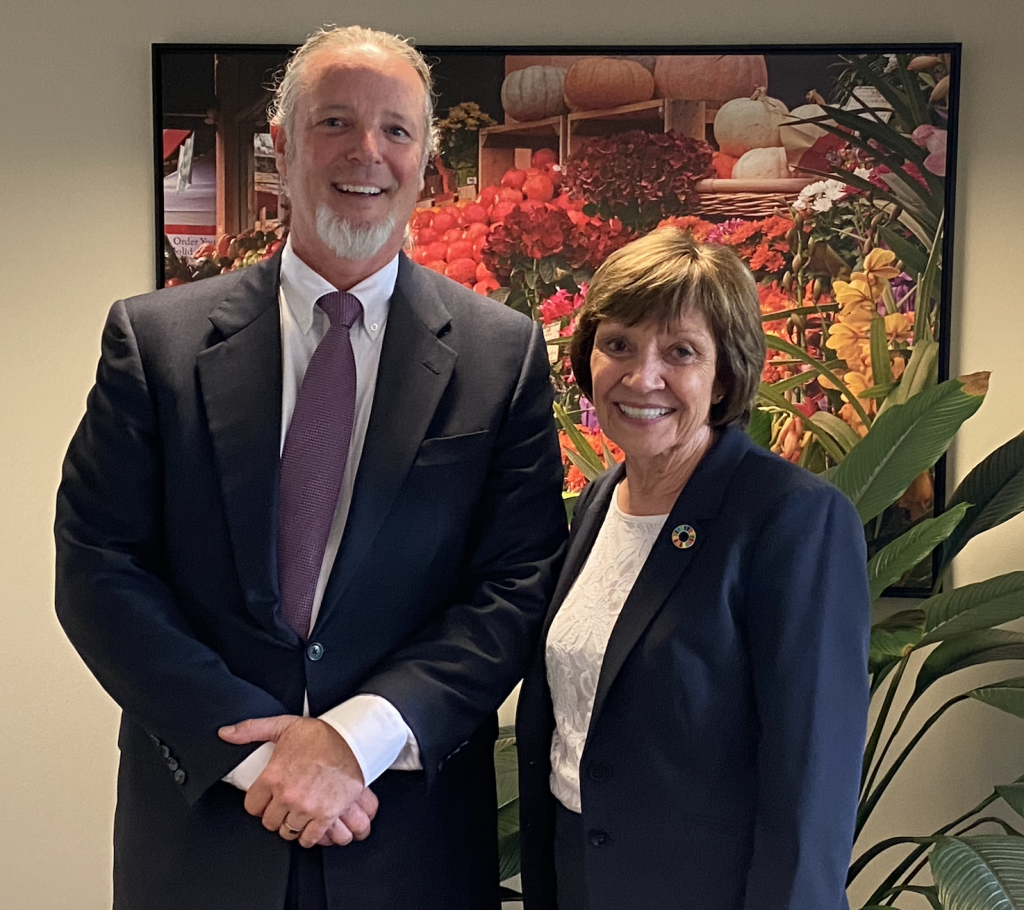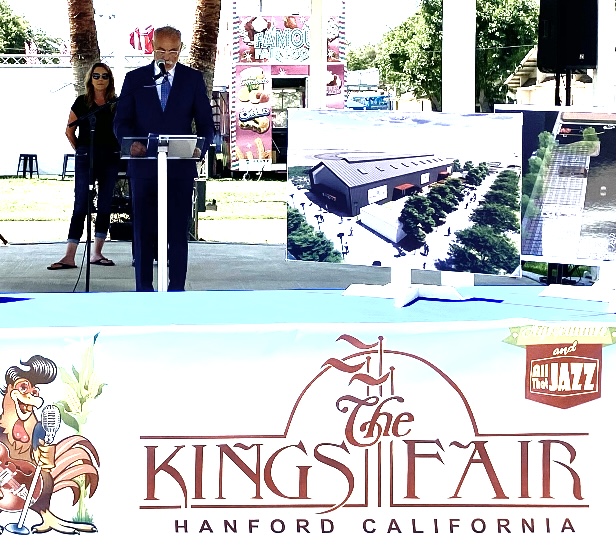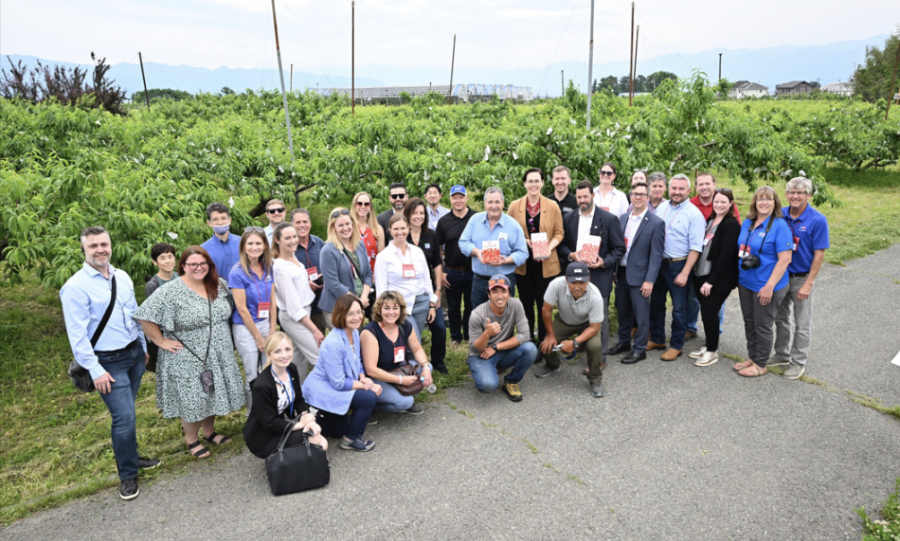-
Recent Posts
- CDFA’s Leslie Fernandez Wins ‘Women Making a Difference’ award
- Secretary Ross joins UC ANR to introduce California AgTech Alliance; funded by California Jobs First
- The Climate Resilience Strategy for California Agriculture is out for public review
- Agritourism – California’s Pumpkin Patches: Hunter Farms
- CDFA Undersecretary Christine Birdsong counts down California CRUNCH!
Recent Comments
- Micah on Secretary Ross on Water, Workforce, and the Future of California Agriculture — from AgNet West
- CA agriculture value surpasses $60B | Western Livestock Journal on Value of California Ag production tops $60 billion for first time
- Kathy de Contreras on CDFA IT department honored at “Best of California” awards
- El costo económico de las deportaciones masivas ya es visible en California - Espanol News on Nine California Counties Make Top-10 List for Ag Sales in the U.S.
- Deportations are taking a toll on California’s economy – and have only just begun – The News Beyond Detroit on Nine California Counties Make Top-10 List for Ag Sales in the U.S.
Archives
- October 2025
- September 2025
- August 2025
- July 2025
- June 2025
- May 2025
- April 2025
- March 2025
- February 2025
- January 2025
- December 2024
- November 2024
- October 2024
- September 2024
- August 2024
- July 2024
- June 2024
- May 2024
- April 2024
- March 2024
- February 2024
- January 2024
- December 2023
- November 2023
- October 2023
- September 2023
- August 2023
- July 2023
- June 2023
- May 2023
- April 2023
- March 2023
- February 2023
- January 2023
- December 2022
- November 2022
- October 2022
- September 2022
- August 2022
- July 2022
- June 2022
- May 2022
- April 2022
- March 2022
- February 2022
- January 2022
- December 2021
- November 2021
- October 2021
- September 2021
- August 2021
- July 2021
- June 2021
- May 2021
- April 2021
- March 2021
- February 2021
- January 2021
- December 2020
- November 2020
- October 2020
- September 2020
- August 2020
- July 2020
- June 2020
- May 2020
- April 2020
- March 2020
- February 2020
- January 2020
- December 2019
- November 2019
- October 2019
- September 2019
- August 2019
- July 2019
- June 2019
- May 2019
- April 2019
- March 2019
- February 2019
- January 2019
- December 2018
- November 2018
- October 2018
- September 2018
- August 2018
- July 2018
- June 2018
- May 2018
- April 2018
- March 2018
- February 2018
- January 2018
- December 2017
- November 2017
- October 2017
- September 2017
- August 2017
- July 2017
- June 2017
- May 2017
- April 2017
- March 2017
- February 2017
- January 2017
- December 2016
- November 2016
- October 2016
- September 2016
- August 2016
- July 2016
- June 2016
- May 2016
- April 2016
- March 2016
- February 2016
- January 2016
- December 2015
- November 2015
- October 2015
- September 2015
- August 2015
- July 2015
- June 2015
- May 2015
- April 2015
- March 2015
- February 2015
- January 2015
- December 2014
- November 2014
- October 2014
- September 2014
- August 2014
- July 2014
- June 2014
- May 2014
- April 2014
- March 2014
- February 2014
- January 2014
- December 2013
- November 2013
- October 2013
- September 2013
- August 2013
- July 2013
- June 2013
- May 2013
- April 2013
- March 2013
- February 2013
- January 2013
- December 2012
- November 2012
- October 2012
- September 2012
- August 2012
- July 2012
- June 2012
- May 2012
- April 2012
- March 2012
- February 2012
- January 2012
- December 2011
- November 2011
- October 2011
- September 2011
- August 2011
- July 2011
- June 2011
Categories
- AG Vision
- Agricultural Education
- Agricultural Marketing
- Alternative Fuels
- Animal health
- Animal Welfare
- Asian Citrus Psyllid
- Biodiversity
- Border stations
- BSE
- Cannabis
- Cannella Panel
- Climate Change
- Climate Smart Agriculture
- Community-based Food System
- Conservation
- Dairy
- Drought
- Environment
- Fairs
- Farm Bill
- Farm Labor
- Farmers' Markets
- Fertilizer
- Food Access
- Food Safety
- Food Waste
- Glassy-winged Sharpshooter
- Growing California
- Healthy soils
- HLB
- Hydrogen
- Integrated Pest Management (IPM)
- Invasive Species
- Light Brown Apple Moth
- Livestock ID
- Measurement Standards
- Nutrition
- Organic agriculture
- Pierce's Disease
- Pollinators
- Specialty Crops
- State Board of Food and Agriculture
- Succession Planning
- Trade
- Uncategorized
Pages

June is Pride Month! Diversity, Equity, Inclusion – at CDFA, that’s our commitment
Posted in Uncategorized
Leave a comment
$89 million fairgrounds resilience funding package highlighted today in Kings County
CDFA Deputy Secretary for Fairs Michael Flores (at podium) was at the kickoff event today for the Kings County Fair as it begins its four-day run in Hanford through June 18. Deputy Secretary Flores highlighted an $89 million slate of projects at Hanford and eleven other fairgrounds sites around the state. The projects include new and expanded safe-shelter space, kitchen and sanitation facilities, showers, and various other upgrades. The grants are part of the state’s Fairgrounds Resilience Centers Program.
Posted in Uncategorized
Leave a comment
National Dairy Month — dairy foods a key part of healthy diet
In recognition of National Dairy Month (June), the Dairy Council of California has partnered with the San Francisco 49ers football club for an informative video about dairy’s important contributions to supporting nutrition security and healthy communities.
California is the leading dairy-producing state in the country, and dairy is its highest-valued commodity at more than $7.5 billion.
Posted in Uncategorized
Leave a comment
CDFA inspector discusses Produce Safety Rule on podcast
CDFA environmental scientist Sarah Standiford–of the agency’s Produce Safety Program–recently appeared on a podcast for MyAgLife about Produce Safety Rule inspections and what farmers can expect. Topics included why CDFA conducts food safety inspections, the steps of an inspection, how a grower can prepare, and how CDFA inspectors take an educate-then-regulate approach.
California farms with more than $25,000 in average annual sales of produce (averaged over the previous three years) are now subject to Produce Safety Program inspections to verify compliance with the Produce Safety Rule.
Click here to listen to the podcast.
Click here for information and resources about CDFA’s Produce Safety Program.
Posted in Uncategorized
Leave a comment
CDFA Undersecretary Christine Birdsong joins USDA and food producers on trade mission to Japan
CDFA Undersecretary Christine Birdsong was in Japan this week on a trade mission along with USDA Undersecretary for Trade and Foreign Agricultural Affairs Alexis M. Taylor, representatives from 10 other state departments of agriculture, numerous farm organizations, and 40 agribusinesses looking to connect with future business partners in Japan.
The week included meetings with Japanese buyers seeking to import American food and farm products, meetings with Japanese government officials and industry groups to discuss trade issues, a tour of retail promotions featuring U.S. products, and visits to Japanese farms and packaging facilities.
Photo — Undersecretary Birdsong (standing, sixth from left) and the delegation visit an organic vegetable farm in Japan.
Posted in Uncategorized
Leave a comment
Invasive Species Action Week — CDFA Border Inspection Stations on front line of prevention
A reminder that this is Invasive Species Action Week in California. CDFA works to prevent invasive species from threatening our environment and food supply in a number of important ways, including 16 Border Protection Stations positioned strategically around the perimeter of the state.
Most years, more than 20 million private vehicles and 7 million commercial vehicles are inspected by Border Inspection Station employees to ensure they are pest-free and meet all regulatory requirements.
Watercraft, self-moving vehicles, recreational vehicles and utility vehicles comprise about five percent of the traffic that passes through the stations annually. Commercial vehicles cover more than 25 percent of the traffic. The remaining 70 percent are classified as private passenger vehicles that are screened for routes of travel and determinations of pest risk.
Posted in Uncategorized
Leave a comment
Invasive Species Webinar: “Defending the Golden State”
Secretary Ross featured in webinar panel on invasive species and California’s collaborative efforts to reduce their impacts
In recognition of Invasive Species Action Week (June 3-11), CDFA Secretary Karen Ross joined a stellar panel of invasive species experts in government, academia and beyond for this webinar about the many ways that invasive plants and animals can wreak havoc on California’s environment, farms and economy. They threaten agriculture, of course – and they also pose risks for California’s biodiversity, clog waterways, raise fire risks, and weaken levees and other structures. The discussion focused on how invasive species drive multiple challenges and what we can do to reduce their impacts.
The online event was part of a “Secretary Speaker Series” of webinars hosted by California Natural Resources Agency Secretary Wade Crowfoot. The recorded webinar is available online at https://resources.ca.gov/About-Us/Secretary-Speaker-Series
Posted in Invasive Species
Leave a comment
Secretary Ross meets with US Trade Representative’s chief agricultural negotiator

CDFA Secretary Karen Ross met today in Sacramento with the US Trade Representative’s chief agricultural negotiator, Doug McKalip. The discussion centered on international trade opportunities for California’s farmers and ranchers.
California is the nation’s leading agricultural exporter, with more than $22.5 billion in exports, representing approximately 10 percent of overall U.S. ag exports.
Reminder — USDA hosting webinar tomorrow on LGBTQI+ mental health in agricultural communities
As part of Pride Month activities, the USDA is hosting a webinar tomorrow (June 6), LGBTQI+ Mental Health in Agricultural Communities. This session will focus on the experiences of LGBTQ+ identifying people in agricultural and farming communities across the country.
The webinar–occurring from 11 am to 12:30 pm PDT–will feature a special message from USDA Secretary Tom Vilsack as well as from agency partners at the National Young Farmers Coalition’s Cultivemos Program, the North Central Farm and Ranch Stress Assistance Center, and Not Our Farm.
Posted in Uncategorized
Leave a comment
World Environment Day — Groundwater recharge a key practice as agriculture works to adapt to changing climate
The United Nations has declared today World Environment Day, and it’s an opportunity to revisit challenges brought by our changing climate and explore practices to maintain sustainability in the decades ahead.
In this video, Central Valley farmer and State Board of Food and Agriculture president Don Cameron shows us the work done on his Terranova Ranch to facilitate groundwater recharge.
The state of California is committed to increasing the potential capacity of groundwater recharge by 500,000 acre-feet, as outlined in Governor Newsom’s “Water Supply Strategy: Adapting to a Hotter, Drier Future,” and is expediting groundwater recharge projects so that local agencies may take advantage of this year’s snowpack runoff.
Posted in Uncategorized
Leave a comment






